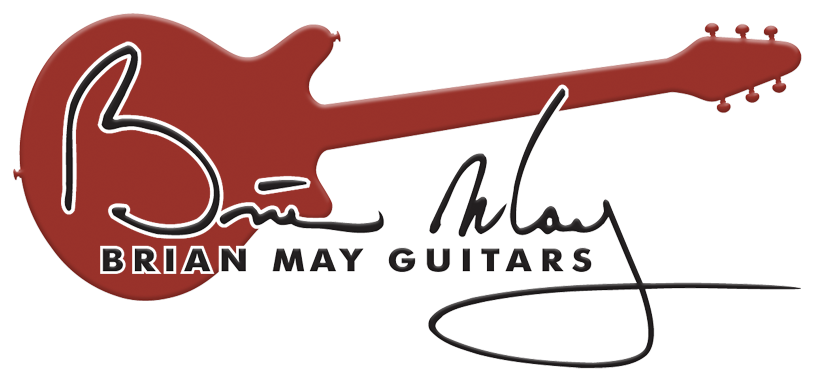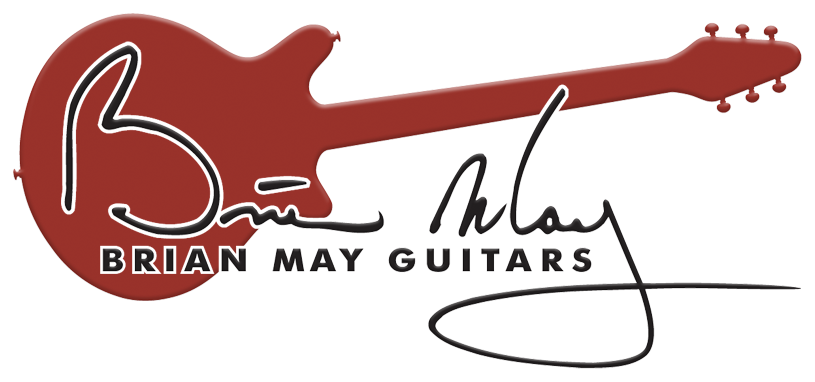The BMG Special
Here is a guide to the principal features of the BMG Special that we trust will help you well on the way to getting the very best from your instrument in any performance environment.
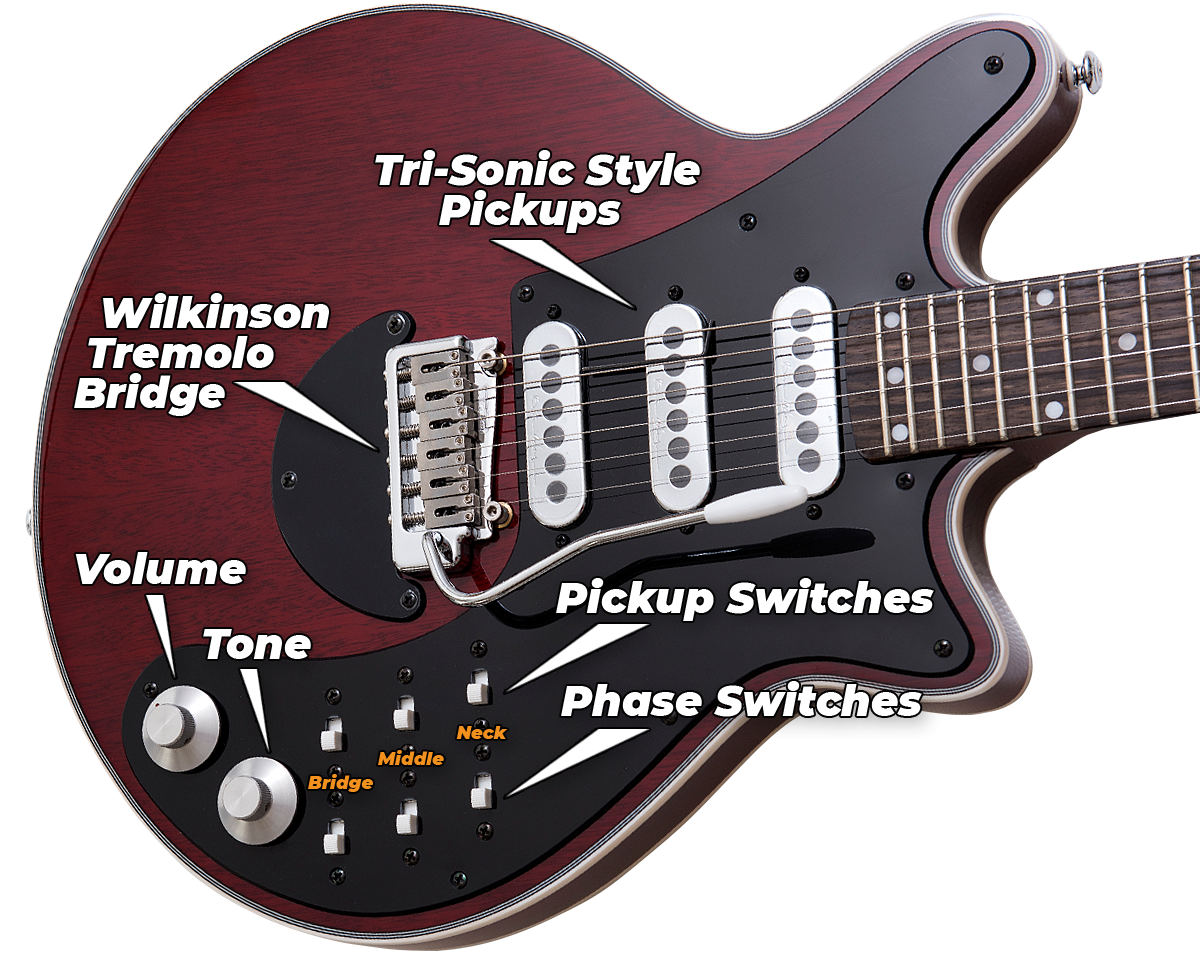
Tri-Sonic Style Pickups
The BMG Special features three BM brand Tri-Sonic style single-coil pickups. These are modern replicas of the Burns Tri-Sonics that Brian and his father installed on the Red Special and, whilst there are some technical differences (their impedance is noticeably higher) they produce a faithfully accurate reproduction of the original tone.
First developed for use on Ormston Burns guitars in 1960, The term "Tri-Sonic" derives from the fact that the unit picks up sound from three points - the top and both sides - meaning that the vibration of the strings is sampled from a longer than usual length. In combination with the orientation of their isotropic ceramic magnets and the unique manner in which the coils are wound, such pickups produce a distinctive “big, round sound” with a richer harmonic content than any conventionally wound pickup.
The three pickups are wired in series for increased output and a fuller signal. When more than one pickup is active the resultant tone is more akin to that of a humbucker, with considerably more warmth and gain than a traditional parallel wired single-coil arrangement.
In addition, the middle pickup is reverse wound and reverse polarity (RWRP), emulating the configuration employed by Brian and his father. The pickup's magnetic pole is reversed and its coils physically wound in the opposite direction compared to the other pickups. Hence, when the middle pickup is selected in combination with either or both of the other pickups in phase, a hum-cancelling effect is created, reducing noise and hum in the output of the guitar.
In combination with the phase switching system employed on The BMG Special, the sound of the selected pickups can be tailored to produce an incredible variety of tones.
Use of the volume and tone controls also allows for subtle colouring of the response.
BM Switching System
The BMG Special and Super models both feature two banks of three switches which control the pickups, with the orientation of the switches matching the pickup location - bridge to middle, left to right.
Pickup Switches
The top bank of switches provides simple ON/OFF control for the three Tri-Sonic style pickups - Each pickup has its own dedicated switch... DOWN is ON, UP is OFF.
Just one of the tricks that maximizes the incredible versatility of the BMG Special, this system allows for the pickup combinations of ALL 3 PICKUPS ON and NECK + BRIDGE, configurations not usually available on other, more conventional three pickup instruments. It also provides a true stand-by option, handy for both stage and studio performance. Simply flick all three switches to the UP/OFF position to silence the instrument's output signal.
Phase Switches
The bottom bank of switches controls the phase of the signal from each pickup - Engaging the switch reverses the phase of each pickup individually, allowing the pickups to be either IN PHASE or OUT OF PHASE relative to each other in any pickup combination.
Without taking a deep dive into the science of sound waves, it's probably easiest to adopt the convention that with its switch in the UP position, the output of the pickup has a POSITIVE phase, and in the DOWN position it has a NEGATIVE phase. Hence, when two pickups are selected and both phase switches are in the same position (either both UP or both DOWN), they will be In phase - if one switch is UP and the other is DOWN, the pickups will be out of phase
When two pickups are selected and in phase, their signals work together and sonically reinforce each other with the resultant output louder than either pickup on their own. When they’re out of phase, they work against one another, cancelling many frequencies. The resulting tone is the “leftovers” from these cancellations, typically rich in mid to high frequencies with the low frequencies reduced, giving the sound a characteristic thin, sharp quality.
Note that it is the reversal of the phase of two pickups RELATIVE to each other that yields the In phase or out of phase effect. Reversing the phase of a soloed, single pickup will have no significantly audible result - e.g. the bridge pickup by itself will sound the same regardless of the position of its phase switch.
For example, with the bridge and middle pickups active: sliding BOTH phase switches to either the UP or DOWN position will put the pickups in phase and produce the same, full sound favoured by Brian for much of his rhythm guitar work. Sliding the bridge pickup phase switch DOWN and the middle pickup phase switch UP will produce a thinner, out of phase tone. If the positions of the phase switches are reversed, the out of phase output will be broadly * the same.
Although the switching matrix ostensibly provide twenty-one different pickup/phase combinations, there is a degree of apparent redundancy due to the fact that some settings produce similar results as explained above. Of course, that still leaves an abundance of 13 possible unique combinations (14 if you include the "kill-switch" function), making the Special an extremely versatile and powerful creative instrument.
* As has been discussed extensively amongst the RS community, the choice of which pickups to put out of phase in any pickup combination will make a subtle difference to the resulting tone, due to the phase relationship of each pickup coil relative to the adjacent coil and to the loudspeaker of the amplifier used. However, please be aware that your mileage may vary considerably, depending on the signal path and set-up, with regard to the significance of the perceived tonal variation between ostensibly duplicate combinations.
Sounds & Settings
The unique nature of its pickups and wiring scheme provide the BMG Special with an awesome arsenal of tonal possibilities and the real fun of this instrument is exploring the different configurations for yourself but, just to give you a brief, introductory “tone tour”.
Plugged in, with a clean amp tone, the bridge pickup alone is pleasantly thin and quite Strat-like. The middle pickup is louder and fatter with a good crisp attack, with the neck pickup comparable in volume to the middle, but with a fuller low end and a softer attack.
As you combine pickups, in phase, the overall volume increases. Adding the middle to the bridge adds power and knocks off some top end, while neck plus bridge equals a warmer, more powerful Strat-type mix. Middle and neck create a thick, semi-solid jazz style voice.
Activating the phase reverse switches typically lends a thinner, sharper tone to a dual pickup mix but, with three pickups on, you can experiment with different phase combinations to sometimes subtle and often rather dramatic effect.
For example, all three pickups on produces that thick creamy tone that has been used for the cello sections of Brian May's guitar orchestrations. However, reverse the phase of the middle pickup and the bottom drops out, leaving you with an agressive, snarling Telecaster or Gretsch-like twang.
Cranked up, the guitar is very resonant and the out of phase tones really begin to make sense in such an environment, adding a cutting harmonic edge, with Brian's most used tone - bridge and middle pickup in phase - certainly replicating a modern, middle-heavy humbucker. Take a listen to the guitar solo on "Bohemian Rhapsody"... that crying guitar tone is created by having the neck and the middle pickups in series and out-of-phase... and then driving the hell out of the amplifier!
Wilkinson Knife Edge Tremolo
The current BMG Special features Trevor Wilkinson's WVP "Wave" 2-point, Knife Edge Tremolo, its strikingly modern, friction-free design offering one of the smoothest actions of any fulcrum vibrato currently available.
With a sleek, low-profile surround restricting the sideways movement of the solid brass saddles, the WVP offers superior comfort, stability and performance.
Features include a stamped steel, heat hardened top plate, 6-screw pivot mounting and a solid steel sustain block with "stagger-drilled" string holes to make corrections to the intonation a relatively simple job, without putting too much stress on the saddles. As with all steel blocks, it helps magnify the overall sustain, brightness and top end, resulting in a more expansive, sharper tone.
The custom, 5mm diameter tremolo arm is secured by a clamping bush inside the block, which can be tightened to taste by a small bolt on the rear of the block. The push-in, thread-less design means that the arm can be positioned at any orientation without interference.
Fitting The Tremolo Arm
- With the tremolo arm placed in the bridge unit, rotate the arm so that it runs parallel to the neck, with its end pointing at the headstock of the guitar.
- Depress the tremolo arm downwards, towards the guitar's body - this will raise up the back of the tremolo block, exposing a small grub screw which locks the tremolo arm in place.
- Use the smallest of the allen keys supplied with your guitar (1.5mm) to tighten the screw to secure the tremolo arm with the desired freedom of movement.
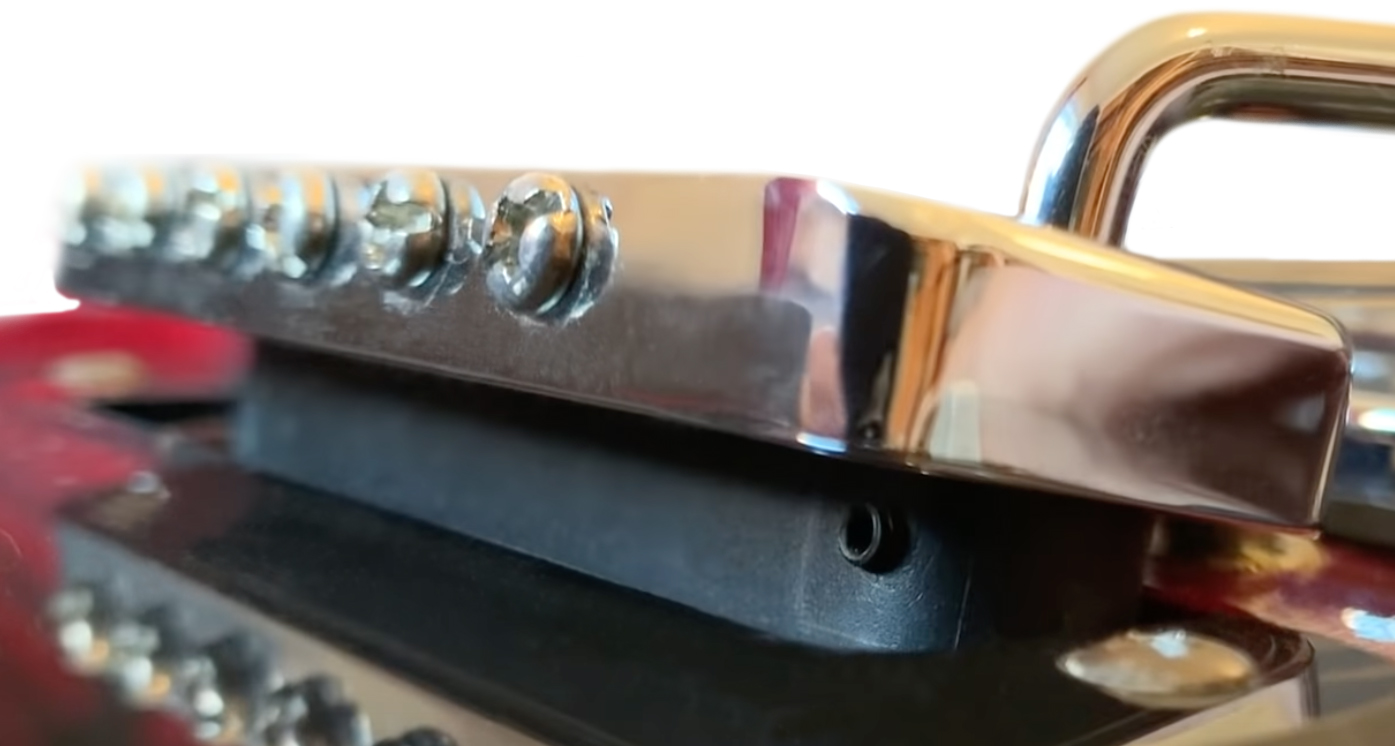
The Wilkinson 2-point tremolo system is designed to "float" due to the balance between the tension of the strings and the tremolo springs - after installing heavier strings, as well as checking the instrument's action / intonation, you may need to adjust the tremolo claw or add an extra spring to compensate for the additional string tension and ensure that the bridge sits level. We provide a spare spring with the BMG Special for precisely this purpose
Thumbwheel Locking Tuners

Featuring an 18:1 gear ratio for precise tuning and a thumbwheel locking mechanism that clamps the string securely, these superb quality machine heads allow you to easily change strings and maintain rock-solid tuning stability, even with lots of vibrato and string bends.
You'll need fewer string wraps, change strings faster, and your tremolo will have more accurate return-to-pitch.
It is recommended to change strings one at a time to maintain tension on the neck and ensure that the floating bridge remains stable.
- Release the string tension by rotating the tuner button
- Loosen the locking thumbwheel on the rear of the machine head
- Remove the old string
- Thread the new string through the post-hole
- Pull the string tight
- Tighten the locking thumbwheel until it contacts the string, making sure not to over-tighten
- Tune string to pitch
- Snip the string
Grover Rotomatic® Tuners
BMG Special and Arielle models manufactured prior to Summer 2021 were equipped with Grover 406 Mini-Locking Rotomatic® Tuners.
- Turn the tip of the string post until it clicks into place. This will align the string post holes
- Note that the string hole is off centre. Turn the tuner to rotate the post until the string hole is positioned away from the machine head, in line with the neck. Thread the entire length of the string up through the bottom of the hole and pull to tension by hand.
- Holding the end of the string, begin tuning. At first, only the inner Locking Cam in the string post will turn. Once the string is securely locked, the outer post will turn.
- Tune string to pitch, usually in under one string post revolution.
- Snip the end of the string.
Serial Numbers
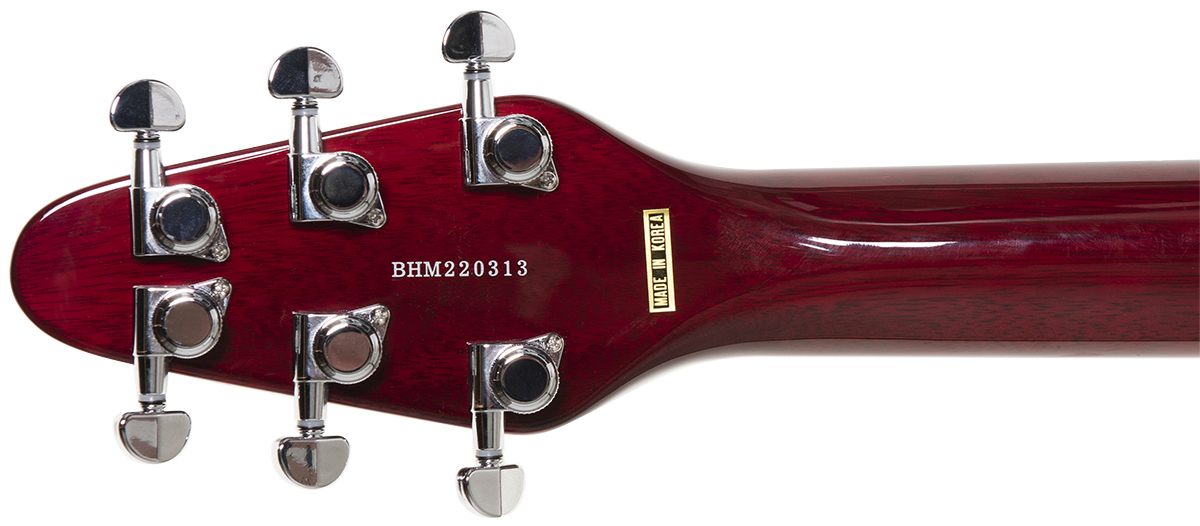
Current BMG Special models bear a unique BHM prefixed 5 or 6 digit serial number located on the reverse of the headstock.
The first 2 digits indicate the year of production.
i.e. 23xxxx = 2023 / 15xxxx = 2015 / 10xxx = 2010 / 09xxx = 2009
The remaining digits indicate the manufacturing sequence.
Some earlier models produced before 2010 — including the first generation BMG Special (the so-called "transition" model c. 2004-2005) and the Mk. 2 revision (c. 2006-2008) — have a 4 or 5 digit serial number sequence where the first digit denotes the year of production.
i.e. 5xxx = 2005 / 7xxxx = 2007
